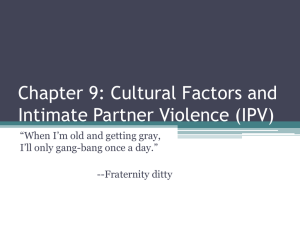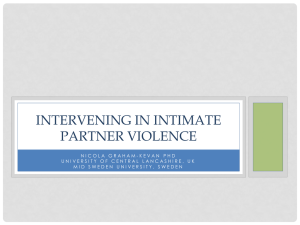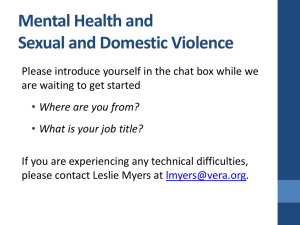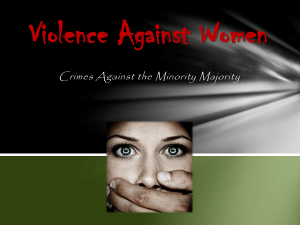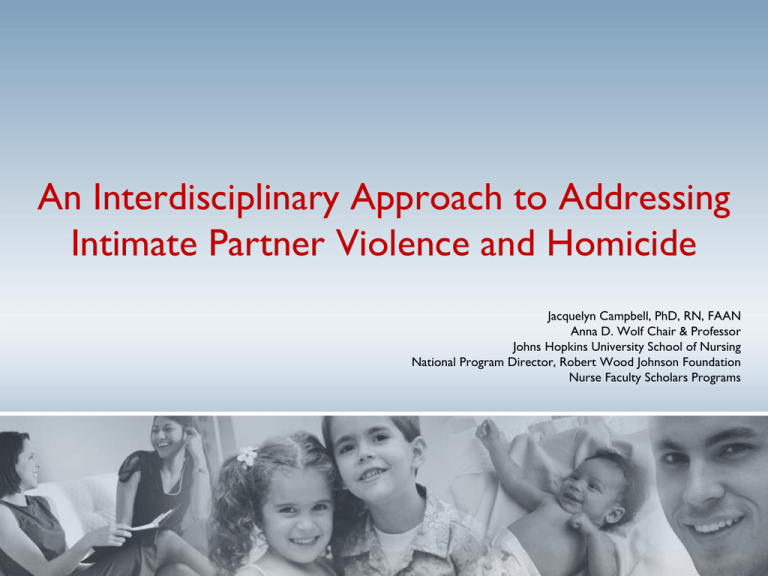
An Interdisciplinary Approach to Addressing
Intimate Partner Violence and Homicide
Jacquelyn Campbell, PhD, RN, FAAN
Anna D. Wolf Chair & Professor
Johns Hopkins University School of Nursing
National Program Director, Robert Wood Johnson Foundation
Nurse Faculty Scholars Programs
“Coaching Boys Into Men” – Futures Without
Violence (www.futureswithoutviolence.org)
RCT Miller et al, J of Adolescent Health 2012
Dynamics of Domestic Violence –
Definitional Issues
CDC: Physical and/or sexual violence (use of physical
force) or threat of such violence; or psychological/
emotional abuse and/or coercive tactics when there
has been prior physical and/or sexual violence; between
persons who are spouses or non marital partners
(dating, boyfriend-girfriend) or former spouses or non
marital partners (Saltzman et.al. ‘99)
Gender Based Violence (GBV) – WHO – behavior
causing harm based on gender or gender identity
Versus emotional abuse/controlling behavior a form of
violence if occurs by itself
Gender Symmetry – Archer ‘00; Straus; Dutton
Theoretical approaches
Typology: M. Johnson ‘95; ‘00; ‘03
Patriarchal Terrorism – originally – now Intimate
Terrorism : gender asymmetry - male patterns of power
& control; less difference across SES; increasing severity &
frequency
Situational Couple Violence (mutual violence): gender
symmetry; violent conflict resolution; more influence of
other violence risk factors
SCV as precursor of IT?
Not as easy to differentiate as hypothesized
Frye et al ’07 – 3 types – moderate control
Johnson (2004; in press) additional category of violent
resisters & mutual control (very small numbers)
Major risk factors for adult DV –
Trauma Framework
For both men & women – growing up in a home where
adults hit each other or children to deal with conflict
Children seeing father hit mother/mutual violence – Sx of PTSD
Children physically/sexually abused – PTSD & neurophysiological
effects
Intergenerational transmission – used to be assumed cognitive –
learning – now more evidence of through trauma – probably
combination
Substance abuse – both male & female perpetrators
Substances often used by trauma survivors to deal with Sx
For male perpetrators of DV- unemployment
Other trauma – e.g. veterans with PTSD – both Vietnam vets
& Iraq 2 & Afghanistan – more likely to abuse wives/children
Death
Early
Death
(cardiovascular,
suicide, HIV)
Mental & Physical
Illness, Disability
& Social Problems
Scientific
gaps – the how
Adoption of
Health-risk Behaviors
Social, Emotional, &
Cognitive Impairment
Adverse Childhood Experiences: child abuse &
neglect, growing up w DV, substance abuse, mental illness
at home, parental discord, crime
Conception
ACE’s Study N = 17,421 Kaiser members – 75% white; 75% college educated
ACE Study website www.cdc.gov/nccdphp/ACE
Prevalence of Childhood Abuse by Frequency
of Witnessing Domestic Violence
100
Frequency of witnessing
domestic violence
Never
Once,Twice
Sometimes
Often
Very often
Percent (%)
80
60
40
20
0
Emotional
Physical
Childhood Abuse
Sexual
ACEs tend to come in groups…
Additional ACEs (%)
1
2
3
4
If you had:
A battered mother
95
82
64
48
>5
52
Adverse Childhood Experiences Score
Trauma “Dose”
Number of individual types of adverse
childhood experiences were summed…
ACE score
0
1
2
3
4 or more
Prevalence
33%
26%
16%
10%
16%
ACE Score & Risk of Being a Victim of
Domestic Violence (perpetration not asked)
Women
Men
15
10
5
0
0
1
2
3
4
>5
ACE Score
0
1
2
3
4 >5
Violent Families are Traumatized
Families
Trauma makes draws a path through the body –
mental and physical health & behavior affected
Trauma Trails – Indigenous peoples – Judy Atkinson
Healing from trauma needs to be an important part
of the solutions to violence – primary and secondary
prevention
CDC NISVS Survey Results on IPV Victimization
(weighted prevalence) Health Outcomes (2011)
Physical violence
Rape
Females Females Males
lifetime Past Year Lifetime
Males
Past Year
32.9
4
28.2
4.7
9.4
.6
*
*
Stalking
10.7
2.8
2.1
.5
Rape, physical violence, &/or stalking
35.6
5.9
28.5
5
With IPV-related impact (fear, PTSD Sx, Injury,
pregnancy, STI, missed work, need for services)
28.8
-
9.9
-
Severe physical violence (vs. push/shove/slap)
24.3
2.7
13.8
2
Any psychological aggression (expressive or
coercive control)
48.8
13.9
48.4
18.1
Injury/needed medical care from IPV
14.8/7.9
4/1.6
*Cell size too small or standard error too large www.cdc.gov/ViolencePrevention/NISVS
Disproportionately higher among AI/AN, African American & Multiracial Women
Fatal Health Outcomes
Average of 1600-1700 IP homicides per year of
women – 500-600 for men (BJS ‘09) - #1 risk factor –
prior DV against female partner (NVS –about 5:1F:M
DV incidents)
45-47% of women killed seen in health care system before
homicide; 83% of cases somewhere in system (Campbell ‘03;
Wadman ’01) – including CPS
Approximately 10,000 children per year see mother killed
or nearly killed by father/father figure or first to find body
(Hardesty, Campbell et al ‘08)
Homicide now leading cause of Maternal Mortality in
entire state of MD, also NYC, Chicago (Chang & Horon,
2010; Palladino, Singh, Campbell et al 2011)
HOMICIDE IN ABUSIVE RELATIONSHIPS
40 - 54% OF US WOMEN KILLED -BY HUSBAND, BF
OR EX (vs. 5-8% of men) (9 times rate killed by a stranger)
7th leading cause of premature death - US women; #2
cause of death-Af-Am; #3 AI/NA women 15-34 yo
Immigrant women at increased risk - NYC (Frye, Wilt ’10)
At least 2/3 of women killed – battered prior – if male
killed – prior wife abuse -75% (Campbell, ‘92; Morocco ‘98)
More at risk when leaving or left 1st 3 mos & 1st year
(Wilson & Daly, ‘93; Campbell ’01; Websdale ‘99)
Eventually more safe
Urban IP femicide decrease vs. rural increase (Gallup-Black
‘05)
Women far more likely victims of homicide-suicide (29%
vs. .1% male in US)
National Death Reporting System 2003-09
(Logan et al ’08; Smith, Fowler, Niolon ‘14)
17 states (OR, AK, NV, NM, OK, MI, WI, OH, CA, KY,
NC, SC, GA, MD, MA, UT, RI, VA, ) – 2903 IP Homicides –
77% female victim (n = 2235)
54% overall guns used; 10.9% of females strangled
Victims 52% White; 35% Black; 7.8% Hispanic; 4.9% other
849 male perpetrator killed self after (38%) (59% white; 25% Black;
10% Hispanic)
460 incidents – Familicide
91.4% Male perpetrator; 77% non hispanic white
80% - (N = 380) male intimate partner killed wife, GF or ex &
other family member, most often a child & often self - 88% gun
used
N = 350 child (<17) killed (10% of femicides) (Websdale
‘99 in FL – 19%)
N = 133 child <11 yo killed
Top Ten States in Femicide 2012
www.vpc.org (US 1.16/100,000)
•
•
•
•
•
•
•
•
•
•
#1 Alaska
9 women killed 2.57/100,000
#2 S. Carolina 50 women killed 2.06/100,000
3 Oklahoma 39 women killed 2.03/100,000
4 Louisiana
45 women killed 1.92/100,000
5 Mississippi 29 women killed 1.89/100,000
6 Nevada
25 women killed 1.83/100,000
7 Missouri
53 women killed 1.73/100,000
8 Arizona
56 women killed 1.70/100,000
9 Georgia
84 women killed 1.66/100,000
10 Tennessee 53 women killed 1.60/100,000
16
Femicide in California - www.vpc.org;
www.cpedv.org
• CA #27 – 2012 - 212 women killed 1.11/100,000 vs. 1.16
•
•
•
•
•
•
•
•
•
but largest # of women killed (as in every yr but 1)
2011 - CA #29 - 193 women killed 1.02/100,000 vs. 1.17 national
2010 - CA #26 - 216 women killed 1.15/100,000 vs. 1.22 national
2009 – CA #31 – 193 women killed; 1.05/100,000 vs. 1.25 national
2008 – CA #29 – 206 women killed - 1.13/100,000 vs. 1.26 national
2006 - CA #25 - 210 women killed – 1.16/100,000 vs. 1.29 national
2003 – CA #22 - 232 women killed - 1.31/100,000 vs. 1.31 national
2002 – CA #20 - 239 women killed - 1.36/100,000 vs. 1.37 national
2001 – CA #22 - 238 women killed – 1.42/100,000 vs. 1.35 national
• State data – approximately 65% killed by intimate partners
• On average 2 children in each of the homes – therefore in CA
• Approx 2000/yr children witness actual or attempted IP femicide
• Ratio of men to women in CA: 2002 - 128 women killed by intimate
partner vs. 25 men – 5:1 ratio 2008 - 99 women killed 14 men –
Homicide-Suicides
www.vpc.org
• “American Roulette” 2011 – 1st 6 mos 313 events –
691 deaths – 34 incidents in CA (80 deaths)
•
•
•
•
•
•
90-94% male perpetrators
70-75% IP Homicide
89.5% with guns
75% female victims of homicide
66 children and teens witnessed
55 children killed
18
www.vpc.org -2012 Femicide from
Supplemental Homicide Reports – all states but FL
• IP homicide of women – 57.9% of the single female victim, single
male perpetrator – where perpetrator known - wife, commonlaw wife, ex-wife, or girlfriend – (No explicit category for ex-BF
perpetrator – 20% of IP homicide of women)
• Black females murdered by males at a rate (2.46 per 100,000)
nearly two & a half times higher than white females (1.00 per
100,000).
• American Indian & Alaskan Native females (0.98 per 100,000)
murdered by male offenders nearly same rate as white females
• Asian and Pacific Islander females least likely (0.74 per 100,000)
females of any race to be murdered by a male offender.
• Hispanic ethnicity could not be determined on a national level
because of the inadequacy of data collection and reporting.
19
Maternal Mortality – Death During Pregnancy
& First PP Year
• State of MD 1993-08 – Cheng & Horon (2010) examined
medical examiner – autopsy records of women who died
during the pregnancy and the first postpartum year.
Homicides (n=110) - leading cause of death
• Firearms most common (61.8%) method of death.
• Current or former intimate partner was the perpetrator in 54.5% (n=
60) of the homicide deaths and nearly 2/3 of IP homicide victims killed
with guns.
• Also examined medical records during pregnancy of same women –
antenatal care
• In a national study of pregnancy associated homicide, firearms
again accounted for the majority of homicides (56.6%)
(Chang et al, 2005).
20
Overlap between physical, sexual and emotional
abuse (N = 889) (Campbell et. al. ’02 from Ellsberg ’00)
Sexual (N = 243)
32 (3.6)
31
(3.5)
14
(1.6)
166 (18.7)
177
(19.9)
166 (18.7)
Emotional (N = 677)
303 (34.0)
Physical (N = 649)
Coker (’10) Framework;
adapted Campbell ‘14
Cassandra Herrman [cassandraaherrman@gmail.com]
ACE’s
HPA
Immune
System
SGA
PPD
HIV
Injury
Chronic pain
TBI
Sleep
Px
Death – homicide,
suicide, maternal mortality
Suicidality
PHYSICAL HEALTH EFFECTS
• Physical Injury (Facial, fractures, dental,
neurological -
soft tissue, internal, “falls”- Grisso ’91; Campbell et al ‘14)
• (TBI & Strangulation: McClane ’05; Corrigan ’03; Valera &
Berenbaum ’03; Campbell et al 2011)
• Neurological Sx - Coker ’00 – from TBI &/or choking
• IPV & stroke or Sx consistent with a stroke: 2 of 3
•
•
•
•
studies (Black ‘08; Lown,‘01; Loxton ‘06)
Chronic Pain (Back, abdominal, chest, head) (Campbell
‘00; Coker ’02;. Wuest et al ‘09)
• Fibromyalgia (Alexander ‘99; Walker ‘00)
Chronic Irritable Bowel Syndrome (Drossman ’98; ‘04)
Hypertension (Schollenberger et al ’02; Coker ’99)
Smoking (30-34% IPV 13-15% controls) (MMWR ’08)
“Choking”: A Potentially Lethal Act
• Attempted Strangulation – but often no visible injury
• Hoarseness; incontinence
• Internal swelling, petichiae, marks visable under enhanced light
• Increased risk of death w/in 24-48 hrs – stroke, aspiration
• Increases risk of CNS Sx – anoxia – memory loss, seizures
(Campbell et al in press)
• Increases risk of IP femicide (Glass et al ‘08) – 50% of
actual/attempted vs. 10% other abused women
• 6.70 AOR (95% confidence interval [CI] 3.91–11.49) of
becoming an attempted homicide
• 7.48 AOR (95% [CI] 4.53–12.35) of becoming an actual
homicide
• Tertiary prevention of choking = prevention of IP homicide
24
TBI in Abused Women – From Repeated
Choking &/or Head Injury – ACAAWS study
HI = Head Injury (including broken jaw)
HI w/LOC = with Loss of Consciousness
Choking = Attempted Strangulation (1/3 > 1)
30.00%
20.00%
IPV (Cases)
No IPV (Controls)
No IPV (Controls)
10.00%
0.00%
HI
HI w/LOC
Choking
IPV (Cases)
ACAAWS Study – African
American & African American
women in the USVI & US –
first 832 women – case
control design
ACAAWS Study – TBI - CNS Sx
9
7
8
6
7
5
6
IPV
No IPV
4
3
5
Yes
No
4
3
2
2
1
1
0
CNS X Sx # CNS X Sx
Sev
0
Choking CNS
Sx#
HI CNS Sx#
Data from BRFSS (MMWR ’08; Breiding,
Black & Ryan ’08a & b)
Women -lifetime IPV
High Cholesterol: AOR 1.3 ([CI] = 1.1--1.4)
Disability AOR = 1.7; activity limitations 2.1
Arthritis AOR = 1.6
Heart Attack; Heart Disease; Stroke :1.4; 1.7; 1.8
Smoking AOR = 2.3
Risk factors for HIV/STD’s 3.1 (CI = 2.4--4.0).
Men: increased use of disability equipment, arthritis,
asthma, activity limitations, stroke, risk factors for HIV
infection or STDs, smoking, and heavy or binge drinking.
(AOR’s 1.4 (CI = 1.0--2.0) - stroke to 2.6 (CI = 2.0--3.6)
– HIV/STD risk
Well established negative health
outcomes of IPV – new findings
Forced sex – continuum of behaviors (physical force
or threats of force); other threats; pressure
HIV/AIDS intersections (Campbell et al ‘08; Jewkes et
al 2010; Kouyoumdjian et al PLoS ONE 2014)
physiological as well as behavioral
USA - Sareen, Pagura, & Grant, GHP ’09 – 11.8% of
cases attributable to recent IPV – rep sample – women
Increased STI’s; cervical cancer (Coker ‘02; ‘03)
Forced first sex – Stockman et al ‘09 – up to 21% of
US women whose first sexual experience <14
Other GYN problems – UTI, vaginal itching/pain; etc
Campbell et al ‘2002; Coker et al ‘02; Campbell &
Soeken ‘99
Abuse During Pregnancy – Health
Correlates
Patterns of abuse during pregnancy – from PRAMS
(‘03)
Unintended pregnancy(Saltzman ’03; Pallito et al, ‘04)
Reproductive coercion
Maternal health correlates: depression, substance
abuse, low social support, spontaneous abortion,
smoking, risk of homicide (Campbell ’92, ‘02; Alhusen ‘12)
Infant outcomes: LBW & SGA (Murphy et. al. ’01 – meta
analysis – CMAJ; Alhusen in press) & through connections
w/ smoking, low weight gain & substance abuse &
stress (Curry et al ’99; Altarac & Strobino ‘02)
Child abuse (most severe - nonbiological father)
Post partum depression – PRAMS analysis – MMWR ‘09
Well established negative health outcomes
of IPV – (C. Mitchell ‘09)
BMI alterations? Chronic pain
Wuest et al ‘09 – chronic pain after IPV ends
From immune system effects – pro-inflammatory response
Gil et al ‘05; Woods et al ‘05
Cutting edge research – intersections with genetics –
telomeres lengthening – Humphreys, Blackburn et al ’11
Mental Health: PTSD, Depression, Suicidality (AOR =
10.4 in African American women), Substance Abuse
MH – Largest proportion of excess cost (Snow-Jones’06)
Co-morbid PTSD & Depression – similar proportions abused
women (15-20%) co-morbid vs. depression or PTSD alone
Suicidality – IPV primary risk (AOR = 10.4 in African American
women – partially mediated by depression/PTSD (ACAAWS ‘12)
Trauma
PTSD
HPA Axis
Alterations
Insufficient
Regulation of
Immune Function
Increased
Cell Mediated
Immunity
INF
IL-2
IL-8
IL-12
IL-1
TNF-a
IL-6
Increased
Acute
Phase
Reaction
Health Declines
Imbalance of
Immune Functions
IL-4
IL-5
IL-13
IL-10
Decreased
Humoral
Immunity
Gill, et al. Perspectives in Psychiatric Care
Insufficient Regulation of Immune Function
Depression by itself more likely to result in immune
system depression – increased susceptibility to
infection, quicker progression of HIV to AIDS &
AIDS related complications
Co-Morbidity of depression & PTSD – common in
abused women – especially if ACE’s or PTSD by itself
– more immune system activation more common
associated with chronic pain, increased BMI, increased
transmission of HIV through vaginal wall,
cardiovascular disease – (Out …Woods et al 2012)
PTSD
Sometimes not diagnosed in abused women b/c of
DSM 4 reliance on Sx tied to 1 traumatic event for dx
DSM 5 should help – Sx not tied to one event
IPV is a pattern of behavior - multiple events for
women who are already commonly traumatized by
multiple lifetime traumas – CAN, CSA, sexual assault –
stranger &/or “dates” &/or partners
Most common presenting problem – sleep disorder
Connections with perpetration of violence through
hypervigilance? with victimization thru retriggering?
Women with co-morbid PTSD & Depression – often
diagnosed with Depression – PTSD missed
From Intra-Agency Task Force: Recommended Action
Steps 2.1: Screen women living with HIV for IPV and link
them to appropriate services.
FVPSP, OWH, HRSA & other relevant agencies will collaborate to ID evidencebased screening, referral & linkage tools for IPV for women living w/HIV.
Agencies will promote those tools to DV & sexual assault & relevant programs
HRSA HIV/AIDS Resource Center will work with Network of AIDS Education
and Training Centers to promote use of tools by HIV service providers
FVPSP & OWH will develop and host a webinar series promoting partnerships
btw health providers & DV programs - include information on the above tools
OPA will include training on the intersection of HIV/AIDS & IPV, including the
importance of concurrent HIV & IPV screening into Family Planning Services
Grants.
SAMHSA will encourage HIV grant service providers to partner w/primary
health care providers to conduct screening for trauma among women living
w/HIV & provide interventions directly or through appropriate linkage to care.
VHA will screen women living with HIV & IPV and link them to appropriate
services either within VA or the community.
http://www.whitehouse.gov/sites/default/files/docs/vaw-hiv_working_group_report_final_-_9-6-2013.pdf
Strategies for Addressing from
a Trauma Framework
Address both physical and mental health problems
Use both targeted as well as universal strategies for
prevention – e.g. safe dates or start strong – dating
violence prevention, healthy relationship building in
middle schools – universal
BUT – also include targeted, healing strategies for
traumatized kids – arts based strategies - & their
families
Routine Screening & Brief Counseling
2012 Affordable Health Care Act
Routine Screening & Brief Counseling
recommended by 2011 IOM report (www.iom.edu)
Accepted by DHHS Sec - being implemented in affordable
health care act as part of primary care women’s health
covered services – 7/2012 – in VA – 2013-14
Implementation charged to office of women’s health at
DHHS www.OWH.gov
USPTF 2013 recommended screening for IPV – all
women of childbearing age – also ACOG ’90 & ’13 &
AAN ’13 & AMA support
Needs to also happen in ED, mental health & in chronic
care settings (e.g. chronic pain, PT)
The case for routine screening & brief
counseling
Prevalence substantial & connected with multitude of
health problems
Indicator based assessment – so many indicators – will we
remember? & will we put our own biases into play
Women do not disclose unless asked
Routine screening desired by majority of women –
abused & not – creates opportunity
Routine screening does no harm –MacMillan et al (JAMA ‘09)
Disclosure process as therapeutic
We will often mis or incompletely Dx & inadequately
treat if we fail to identify current or past IPV
(e.g. CNS Sx w/o identifying TBI from IPV HI or choking; comorbid PTSD & Depresssion)
We know
We know what to “assess” with – Abuse Assessment Screen (Helton
& McFarlane – ’86; Rabin et al, ‘09 AJPM
How to “assess” – computer based approaches well supported - 4
studies – women prefer computerized inquiry – build into HIT –
computer tablets or apps? 4th R app – uses HITS
Trautman et al –’07 - ED & McNutt et al – primary care –
increased disclosure with computerized assessment
O’Connor et al – pediatric primary care setting – well child &
acute illness – handheld
McMillan et al . – ED’s & primary care in Canada
Current study in Baltimore, MD – X3- X4 prevalence with ACASI
system than question on history form or phone same population
EMR system prompts; Houry et al 2011 – Kiosk in ED
Helps address issues of asking badly!! – (Rhodes ’09)
ABUSE ASSESSMENT SCREEN
1. Have you ever been emotionally or physically abused by your
partner or someone important to you?
2. Within the last year, have you been hit, slapped, kicked, pushed
or shoved, or otherwise physically hurt by your partner or expartner?
If YES, by whom
Number of times
3. Has your partner or ex-partner hit you while
you were pregnant?
4. Does your partner ever force you into sex?
5. Are you afraid of your partner or ex-partner?
Mark the area of any injury on body map.
Helton & McFarlane, 1986
www.nnvawi.org
Single Question – Gender Neutral
Are you safe at home? (JHH) – does NOT work
well
Are you afraid (or concerned) that someone at
home or someone you love has (or may) hurt you or
tried to hurt you?
If yes, need to ask specifically about forced sex – or
have a separate forced sex question
Also need to develop well validated & tested
question about perpetration – with attention to
safety of victim - several are working on (e.g. Singh
et al ‘11)
PURPOSES OF ROUTINE
ASSESSMENT
OPPORTUNITY CREATION –
FOR DISCLOSURE, SEEKING HELP EARLY, A PLACE OF SANCTUARY FOR
THOSE NOT READY FOR SHELTER, COUNSELING, CRIMINAL JUSTICE
PRIMARY PREVENTION - EDUCATION ABOUT ISSUE
ACCURATE & COMPLETE DIAGNOSIS & APPROPRIATE
TREATMENT
RATHER THAN DETECTION
Among pregnant women (Renker ’06)
97% not embarrassed, offended or angry – abused & not
Almost ½ of abused did not disclose but would have if
known would not be reported to CPS
Part of new Women’s Health Initiative in VA
Challenge is implementation & what will “brief counseling” look
like
What Matters – System Change –
Campbell et al ‘02
How you introduce the screen
Because domestic violence happens to so many women,
we are asking ALL women
Because domestic violence results in so many health
problems for women…..
The environment – posters – signals we care
Notices in rest rooms
Forms changing
Incentives for staff
Providers knowing there is in house backup
Resulted in increased patient satisfaction in ED’s with
routine screening (Campbell, Coben et al 2001)
What matters – culture & context
Pregnant Adolescents – afraid of CPS notification –
Renker ‘09
Hispanic women in LA – afraid of deportation –
self, - do not know can self petition for citizenship –
VAWA (citizenship classes, English language classes –
content on DV)
perpetrator, - want him to stop, not be deported
family members – he has threatened her with
deportation of family if she discloses
M. Rodriguez ‘07; ‘09
Moving Forward
Identifying best “brief counseling” – warm referral –
Futures w/o Violence www.futureswithoutviolence.org
Incorporating DV prevention & interventions into prenatal
home visitation – DOVE – Sharps et al ‘15
Depends on context – health care setting, availability of
“in house” DV advocate, trained SW, woman’s
preference –who she wants to talk to, where she is
in process of recognition of DV & how it is affecting her
& children’s physical & mental health
of commitment to relationship – not to destroy families
of risk of homicide &/or serious injury (5 item health care
setting DA – www.dangerassessment.org Snider et al (’09)
Danger Assessment
www.dangerassessment.com
5 item version – for health care professionals – Snider et al ‘09
Has the physical violence increased in frequency or severity over
the past 6 months?
Has he ever used a weapon or threatened you with a weapon?
Do you believe he is capable of killing you?
Have you ever been beaten by him while you were pregnant?
Is he violently and constantly jealous of you?
Also be alert for choking/strangulation!
*Cross-validated Hosmer-Lemeshow goodness of fit = 0.12; Area under
the curve = 0.79
Policy Possibilities
If 4 of 5, report to police &/or to DV advocacy
program - her choice – do with her
If 3 of 5, get full DA done – uses calendar, accurately
calculates level of danger - proceed based on results
If 2 of 5 tell her has two of 5 highly predictive risk
factors for serious assault/homicide – highly
recommend further advocacy – offer to call with her
If 0-1 of 5, proceed with normal referral/procedural
processes for DV
DA-YA App – www.onelove.org & itunes
One Love App – DA for women aged 16-26
www.joinonelove.org
Strongest risk factors for fatal
or near fatal – threats to kill or
with weapon
47
48
Interdisciplinary
Community Model
Offenders in CJ, BIP, MH
SA Tx &/or VA/DoD
LAP MD Lethality
Assessment Program
Women/Victims in Shelters
Or Health Care System –
Risk Assessment
(Re-assault)
Partners of Men in System
Lethality Assessment (DA)
& Safety Assessment
Criminal JusticeJudicial System –
High Risk Team (JGCC)
System Safety Audit – CCR, Including Fatality Reviews
& Court Watch/Monitoring (www.watchmn.org)
Strategies for Addressing from
a Trauma Framework
Address both physical and mental health problems –
complex pathways – recognize probable prior trauma
Helps women understand some of the complexities of
their health problems – “wow – so I’m not crazy, it’s just
that I have experienced so much & it has affected my
body not just my head”
Investigate old injuries – multiple injuries
Stress alleviation interventions – work with her on what
makes sense in her life – exercise, prayer, meditation,
trauma informed physical therapy
Also include targeted, culturally based, healing strategies
for traumatized kids, adolescents, families – e.g.arts based
Decision Aid – “Iris” Study –
N. Glass, PI, NICHD
Computerized decision aid (from current personalized
medicine advances) for safety planning for abused women
Tailored to level of danger (Danger Assessment) & type of
abuse
Tailored to area of residence & resource availability –
rural vs. urban, available advocacy
Tailored to culture & citizenship status
Women report decreased stigma concerns
Secondary & tertiary intervention – potential for primary
prevention for children
Being tested in R01 – first wave evidence of Decision Aide
51
decreasing decisional conflict, increasing decisional efficacy
“Trauma Informed Care” –
Physical & Mental Health Care
As well as what has been developed for IPV victims
(Warshaw) – ideally includes assessing for ACE’s also
For combat exposed men & women – combining IPV &
PTSD treatment – Gerlock – VA Center of Excellence Puget Sound; Taft
– PTSD Center in Boston
For perpetrators of IPV – trauma informed abuser
interventions – Saunders ‘07
For low level violent couples before becomes
serious/dangerous – O’Leary ‘09 (APA); Woodlin & O’Leary ‘12
For traumatized, violent families – building resilience
For traumatized children – especially those who have
witnessed DV & to the extreme – IPV homicides
Trauma Informed Care
www.samhsa.gov/nctic/trauma.asp
Approach to engaging people with histories of trauma
Recognizes the presence of trauma symptoms &
acknowledges the role that trauma has played in their
lives.
NCTIC facilitates adoption of trauma-informed
environments in the delivery of a broad range of services
including mental health, substance use, housing,
vocational or employment support, domestic violence
and victim assistance, and peer support.
In all of these environments, NCTIC seeks to change the
paradigm from one that asks, "What's wrong with you?"
to one that asks, "What has happened to you?"
Need for Testing Interventions &
explaining basis to her
“Warm Referral” (Futures w/o
Violence) Tailored to Level of
Danger, her goals, children,
culture, who she wants to talk
to
IPV
Injury
Childhood
Trauma
ACE’s
Trauma
Response
MH Px
Professional
Safety Planning
Including referral
to interventions
for him &
children
Trauma
informed
health
intervention
Increased
Safety –
Increased sense
of Efficacy
Decreased
Stress
Physiological
Mechanisms
Physical
Health
Problems
Improved
Physical &
Mental
Health
Materials to help
www.futureswithoutviolence.org
Opportunities
Futures without Violence (www.endabuse.org)
National DV Hotline 1-800-799-SAFE
www.thehotline.org
National Teen DV Hotline – www.loveisrespect.org
• 866-331-9474 “love is” 77054
CALL WITH HER!!
Deal with her safety AND her health – abuse will
take time to address – need to help with health
problems in meantime
Never forget who it’s for “please don’t let her death be for nothing – please get
her story told”
(one of the Moms of a woman killed)
“I want to be able to see my daughter grow. I want her
to be able to be a little girl. I don’t want to keep the
cycle going. I want her to see good things while she
grows up & not abuse.”
(abused woman)


